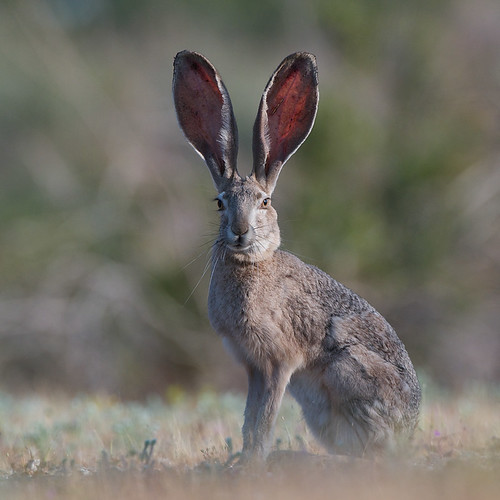How great is this guy! Sometimes called a rabbit, the black-tailed jackrabbit is really a "hare" and hares are different than rabbits.
We have more jackrabbit neighbors in Borrego Springs than people neighbors so I find myself giving the hares a little neighborly wave when we cross paths. That's a Borrego "thing". You wave at everybody... not a big deal since you won't see more than a dozen people some days. People and jackrabbit sightings are pleasant events! 

Female jackrabbits weight more than males (as a woman, this bothers me) - females 11 to 13 pounds, males 9 to 11 pounds. Average length - 16 to 28 inches.
Jackrabbits live mostly alone but come together to mate.
 Jackrabbit babies are called "leverets". They are born with fur, eyes open and able to move about independently (baby rabbit "kittens" are born hairless with their eyes shut). Jackrabbits have 1 to six leverets per litter, every three to four months.
As early as one hour after birth, mother jackrabbit leaves the leverets in separate hiding places and comes back in the evening to nurse each one. This lasts about a month, then "Adios Amigos"!
Jackrabbits eat grasses, leaves, twigs, sagebrush, cacti at night and conserve water by eating their food twice. When they poop out their food the first time, they eat the poop and digest it again, getting even more of the moisture out. Jackrabbits rarely have to drink. Fifteen jackrabbits can eat as much as one full-grown cow in one day!
Jackrabbit babies are called "leverets". They are born with fur, eyes open and able to move about independently (baby rabbit "kittens" are born hairless with their eyes shut). Jackrabbits have 1 to six leverets per litter, every three to four months.
As early as one hour after birth, mother jackrabbit leaves the leverets in separate hiding places and comes back in the evening to nurse each one. This lasts about a month, then "Adios Amigos"!
Jackrabbits eat grasses, leaves, twigs, sagebrush, cacti at night and conserve water by eating their food twice. When they poop out their food the first time, they eat the poop and digest it again, getting even more of the moisture out. Jackrabbits rarely have to drink. Fifteen jackrabbits can eat as much as one full-grown cow in one day!
 |
| Just For Fun |





